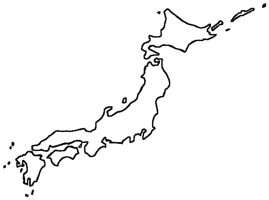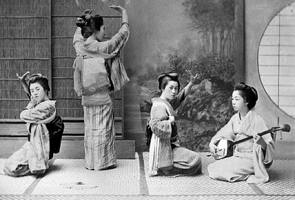
|
The Society of Folk Dance Historians (SFDH)
Japanese Folk Dance
[
Home |
About |
Encyclopedia | CLICK AN IMAGE TO ENLARGE |

|
 Japanese dance may be divided into several categories – highly developed theatre, religious, ceremonial, recreational, classic ballet, and folk or "local" dances. What we generally think of when speaking about Japanese dances are usually those of the Kabuki Theatre, Noh, O-bon, and Geisha dance schools. Because of the Japanese loyalty to the past, however, even the most professional or classic dance exemples, such as those seen in the Kabuki Theatre and the Imperial Court, have a background originating in folk mythology or in folk art.
Japanese dance may be divided into several categories – highly developed theatre, religious, ceremonial, recreational, classic ballet, and folk or "local" dances. What we generally think of when speaking about Japanese dances are usually those of the Kabuki Theatre, Noh, O-bon, and Geisha dance schools. Because of the Japanese loyalty to the past, however, even the most professional or classic dance exemples, such as those seen in the Kabuki Theatre and the Imperial Court, have a background originating in folk mythology or in folk art.
As with the dances of almost any country, those of primitive Japan had their origin in some need to survive, such as a prayer to the gods for a bountiful harvest or for sun or rain; to entice fish to their nets and result in a big catch, such as the famous Fisherman's Dance. The Hunters' Dance(s) were supposed to do the same with game, probably by either acting and moving in such a manner as to entice wild animals to where they may be caught, or as hypnotic lure for other game. These early dances were not done as solos for self-gratification or as ego-tripping, but rather by the entire village as a message to the gods or spirits from all. Some dances were supposed to ward off epidemics or illness, and perhaps they did in a way, for we know now that folk dancing is recommended as a great health benefit. Other ritual dances included those danced in the fields or (especially) in the rice paddies at planting time in the belief that the gods of the fields would be pleased and grant a productive harvest, or at harvest time in appreciation for having had their prayers answered. (History does not mention what kind of dance they did following a severe crop failure though.) Remnants of these dances of the rice-paddies may be found in both the Kabuki Theatre and in the Noh plays.
 Excerpts from the annals of Japanese mythology, Kokoji (712 CE) and Nihon Shoki (720 CE), tell an interesting story of the supposed origin of the art of dance in Japan. It seems that one goddess, in order to entice the Sun goddess out of a cave in which she was hiding, began jumping on an upturned tub in a rhythmic fashion and created a new movement – dance. The other gods and goddesses applauded vigorously, and the Sun goddess, curious, opened the closure of the cave and let the sun out again. It apparently worked, for the sun certainly shines today, and the rising sun is Japan's symbol, and an everlasting reminder of the power of dance. (One might wondeer at the surprise and delight of that group of old deities as they saw one of their number breaking out into a tap dance or flat shoe dance, such as is done in the fields of Japan – atop that old sake cask!)
Excerpts from the annals of Japanese mythology, Kokoji (712 CE) and Nihon Shoki (720 CE), tell an interesting story of the supposed origin of the art of dance in Japan. It seems that one goddess, in order to entice the Sun goddess out of a cave in which she was hiding, began jumping on an upturned tub in a rhythmic fashion and created a new movement – dance. The other gods and goddesses applauded vigorously, and the Sun goddess, curious, opened the closure of the cave and let the sun out again. It apparently worked, for the sun certainly shines today, and the rising sun is Japan's symbol, and an everlasting reminder of the power of dance. (One might wondeer at the surprise and delight of that group of old deities as they saw one of their number breaking out into a tap dance or flat shoe dance, such as is done in the fields of Japan – atop that old sake cask!)
The Bon dance was another form, and performed during the period of Bon, a four-day stretch in mid-July (in some areas, in August). It was usually performed as a processional or by a group in a closed circle. A dance for the souls of the dead, yet the "Bon" dance is looked forward to by everyone, and enjoyed as a dance of participation rather than one to be danced for spectator observation.
Another dance of processional nature was the Furyu. During the Middle Ages, it began to take on the form of a tribute to elegance in art, furnishings, and beautiful clothing, and the procession became a parade of smartly attired people, like the Helston Furry Dance. In time, however, it reverted to a less sedate thing, and is now performed by everyone, along the roads, the highways, and public squares, with no special requirements for costume, stage, or even particular ability.
Dances performed by the Geisha could be in almost any form. It is interesting to note that, outside the Kabuki Theatre, which is all-male, including the parts that call for female characters (in which trained men act the part), Kabuki-type dances are usually performed by female dancers – including the men's parts. This is one of the artistic accomplishments of some of the Geisha.
Folk or country dances are called "local" dances in Japan. They are not nation-wide in scope but rather of a local nature. There is hardly a village, town, or prefecture in Japan that does not have its own folk dance. As in the case of the Bon dance, they are done for the pleasure and enjoyment of those dancing them and not to "show-off" or for the benefit of spectators. Many stem from ancient days and ritual, and are done almost as they were then. Finding them, however, is another story for they are danced as a rule only on special occasions or festival days. A good opportunity to see them is at the annual Grand Gathering of Local Dance Performers, held at Nippon Seinen Kan, once a year in Tokyo. It is then that dancers from all over Japan change their attitudes and go forth especially to please the audiences, in order to "tell" about their particular home locality. They are not competition, or otherwise perhaps than to extol their home villages, and their dancing is still primarily for their own enjoyment. Still, in order to make room on the programs, only the best dance groups form any one style or area are selected.
In recent times, though, Japanese folk dances have taken on a new look of sorts, and some Geisha have created or choreographed "local" dances on their own for performance in dance salons and Geisha parlors. Does something there sound familiar?
DOCUMENTS
Printed in Folk Dance Scene, January 1978.
This page © 2018 by Ron Houston.
Please do not copy any part of this page without including this copyright notice.
Please do not copy small portions out of context.
Please do not copy large portions without permission from Ron Houston.